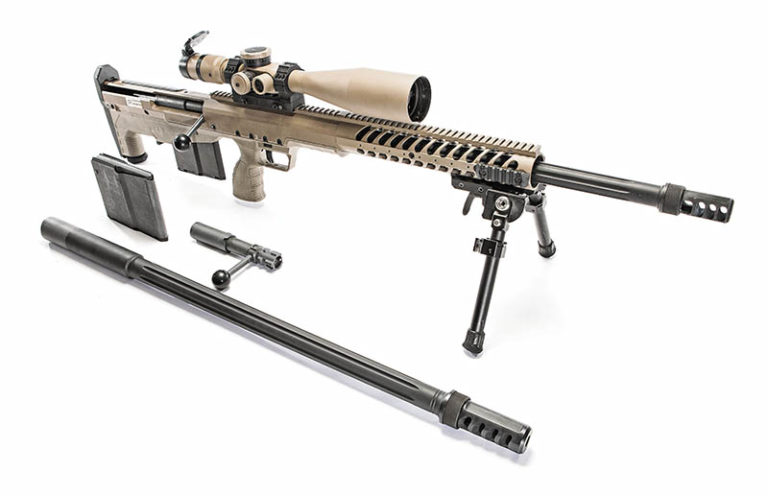
The Desert Tech HTI, or Hard Target Interdiction, blurs the line between precision rifle and portable artillery.
For some shooters, long range just doesn’t cut it. There are simply never enough foot-pounds or feet-per-second to satisfy these people. It’s a uniquely American dilemma and we, for one, admire those esoteric shooters and savvy engineers, pushing the very ragged edge of handheld ballistics. But where do you turn when you want something that flies like a fighter jet and hits like a freight train? Two words: Desert Tech (DT).
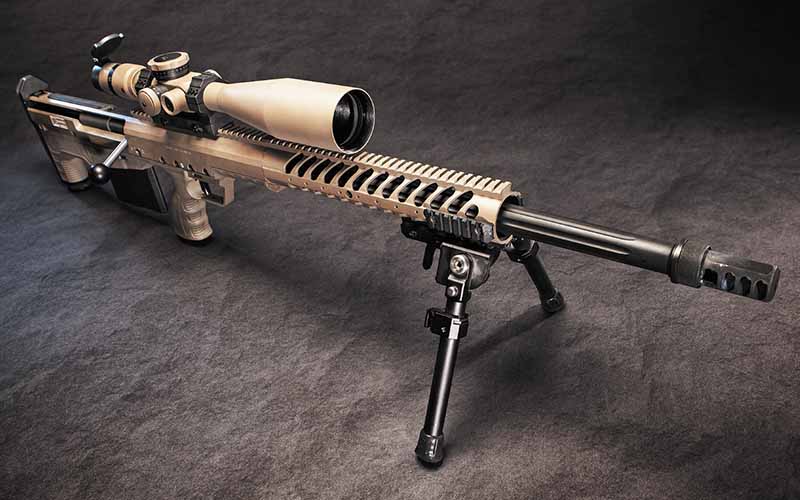
The folks at DT are artisans of the bullpup rifle, particularly those who are intended to shoot far …very far. They’re a relatively young company, less than a decade old, but have excelled in their very narrow niche of extended-range bullpup bolt guns. Its product line is essentially three separate chassis systems available in a total of 13 calibers. That’s not a whole lot and, from a business viewpoint, there’s little margin for error. But DT is equal parts manufacturer and ballistic think tank. Its products offer innovative features and an über-long-range capability that few other gun makers can claim to match. To be perfectly blunt, DT’s weapons impress the hell out of us.
Living Out a Fantasy
The crown jewel in Desert Tech’s current lineup is its HTI—the Hard Target Interdiction rifle. It is a scaled-up version of its original rifle (the SRS) intended to push massive bullets to mile-plus ranges. It’s the biggest firearm that I’ve ever tested and, even though I’ve eschewed bullpup guns for the most part, I was pleasantly surprised and impressed by the HTI’s suite of features.
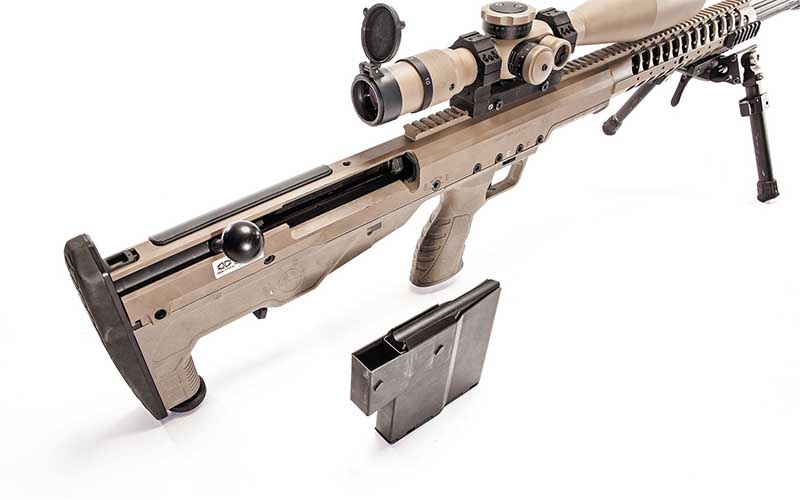
The HTI is available in four calibers: .375 CheyTac, .408 CheyTac, .416 Barrett and .50 BMG. In the latter, the HTI is entirely capable of being employed as an anti-materiel rifle without missing a beat, and we wouldn’t be surprised if someone somewhere has purchased a squad’s worth of them for that purpose. Unfortunately due to time and ammo constraints, and a lack of enemy light armor in our A.O., we weren’t able to evaluate this particular capability. What we offer you instead is a brief but poignant long-distance accuracy evaluation.
We had a total of 40 rounds to put through this rifle—generously provided by Desert Tech. (Yes, the folks there make their own long-range ammo, as well. We’ll get back to that in a moment.) As most of our T&E’s go, 40 rounds is barely a break-in period.
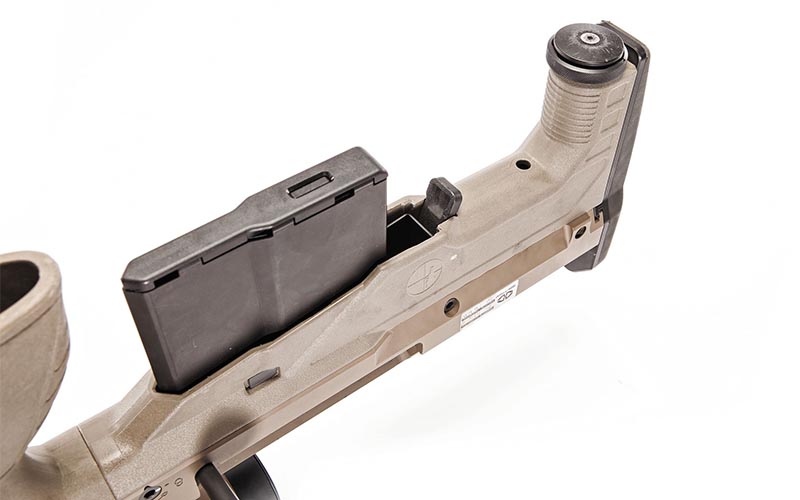
But, in the end, this turned out to be more than enough to give us a deep appreciation of this rifle’s potential. Once you purchase the HTI, chassis conversion kits are available through DT (and authorized dealers) and all that’s required is a bolt, barrel, and magazine change to go from one caliber to another. It’s not specifically billed by DT as a “quick change” system, but our experience was that it was pretty damn quick. We were able to do it in just a couple minutes—and that was while being hot, tired and not exactly in a rush under the midday sun. Our test gun showed up in .375 CheyTac with a conversion set for .50 BMG. We had 20 rounds in each caliber to make our case.

Sticking ’Em Up, Knocking ’Em Down
We took the HTI to Cowtown Range in Arizona. It was one of the few ranges we could find within driving distance that has steel set up all the way out to 1,600 meters—the perfect place to let Desert Tech’s big boy stretch his legs out. We started with the .375 CheyTac. The DT ammo that came with our test gun consisted of a 352-grain open-tip boat-tail slug that screams past the muzzle at 3,080 fps. A convenient DOPE (data on previous engagement) chart is included on the side of the box and this loading is listed as zero-drop out to 500 yards. Also, for those who are concerned, the 352-grain OTM projectile has a G1 coefficient of 0.89 and a G7 coefficient of 0.408.
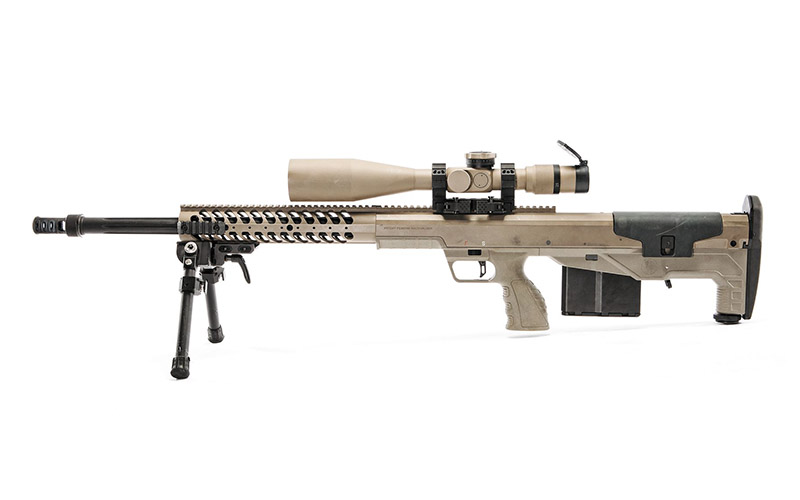
In 20 rounds, we were able to achieve hits at 573, 707 and 1,100 meters. Unfortunately, we were DOPE’ing our gun on the fly against aggressive terrain with fish-tailing winds. As such, we were unable to reach out any further before running out of ammo. At the risk of sounding like a kiss-ass, I’m going to take a moment to say that our editor from the land of the Union Jack is an absolutely gifted spotter, and I would’ve been hard-pressed to get any of those hits without his wind calls.
Furthermore, said editor says he had previously made an 1,800-meter shot with an HTI in this caliber at a media demo day. After running the HTI myself, and shooting alongside Iain, I will vouch that both shooter and rifle are well capable of such a feat.
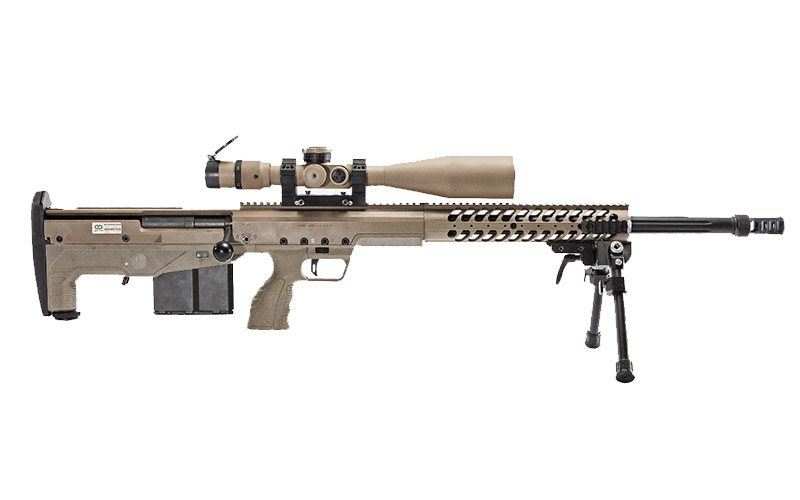
Having exhausted our supply of .375 CheyTac ammo, and gotten a satisfying hit past the one-click line, we swapped calibers and snuggled in behind the .50…
Big Gun Kick the Hell Out of You
Here’s the technical data for all you benchrest ballisticians out there. Desert Tech’s .50 BMG loading is a 750-grain tipped super-match boat- tail that’s heading for the horizon at 2,700 fps. The G1 coefficient is 1.050 and G7 is 0.581.
What’s that mean for the rest of us? The .50 BMG, or Browning Machine Gun, was originally designed for the machine guns (go figure!) of aircraft and armored vehicles. Despite its current employment in precision weapons, it was not built from the outset for that purpose. So, getting .50 BMG ammunition to turn out precision performance has been something of a process over the years. Desert Tech has worked its alchemy and assembled a cartridge they think can do it better. We think they may have cracked the code.
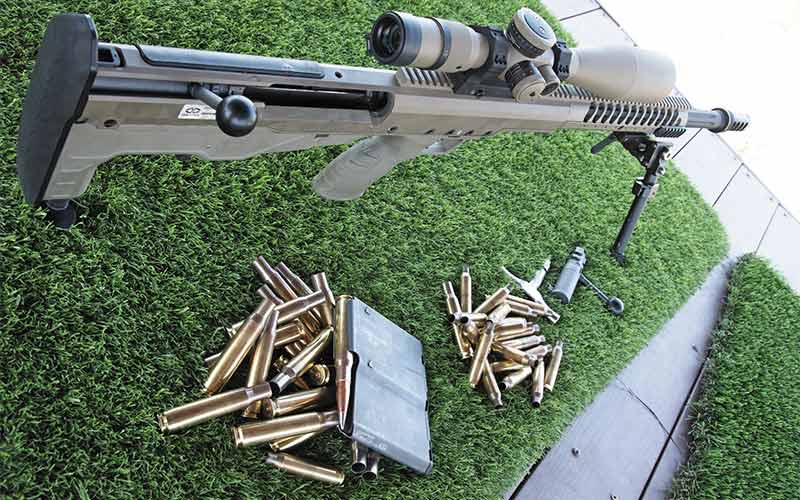
Three of us were on the platform that day. Yours truly, your editor-in-chief, and our shooting partner and close personal friend whom we’ll refer to as KJ. KJ is a retired federal corrections officer with an entire lifetime of shooting experience under his belt. However, this was his first opportunity to get behind a .50-cal., and we were happy to get his input about the experience.
I personally shot all 20 rounds of CheyTac and was 10 rounds into our supply of .50 BMG when my shoulder finally said enough is enough. Iain settled in behind the gun and shot eight rounds of his own and, once we both had hits at distance, we plucked the last two rounds out of the box for KJ, who had gotten shorted out of the .375 because of said DOPE’ing process.
As KJ settled in behind the HTI we coached him into position. I used the spotting scope to box him in on target, and Iain gave him the down-and-dirty on mils and holdovers. The very last thing Iain said to KJ before the shot was, “Make sure you get your head far back from that scope. This thing kicks and, if you’re too close, it’s a self-correcting mistake.”
I was on glass and gave KJ his final wind call. KJ touched off the shot and all we heard after the bang is, “Well … you’re right … that’s a self-correcting mistake.” I looked over just in time to see our poor comrade come off scope with his face, and half the buttstock, dripping blood. We immediately triaged the magnificent gouge just above his eyebrow. Our practice of keeping first-aid gear in our range bag quickly paid off. As soon as we staunched the bleeding and determined there was no concussive or ocular damage, the boss man went hot on the Nikon and snapped the awesome shots you see here.
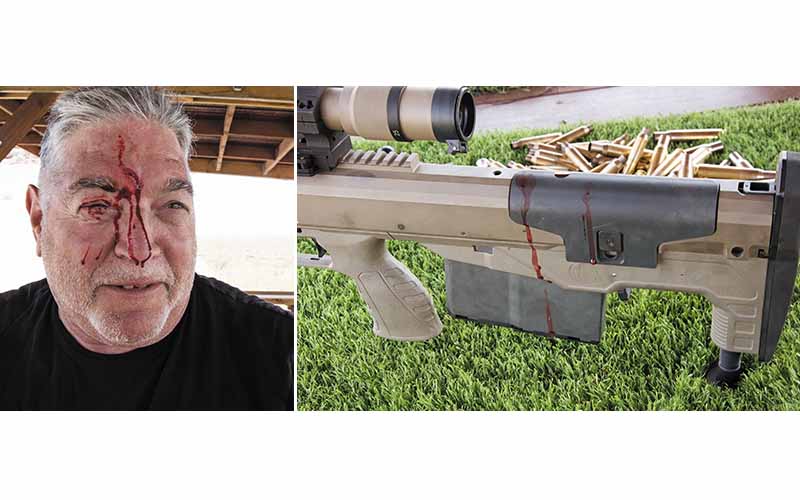
KJ was an excellent sport about the whole thing, and we spent the next five minutes laughing our collective asses off and congratulating him on a successful first-round hit at 1,240 meters. He tied Iain and me for longest shot of the day. It was KJ’s first (and, to date, only) shot from a .50 BMG precision gun ever, so we promised him we’d publish the exact distance for official record. We gave him two rounds but, after the first one, we called it cold and a single round of 750-grain .50 BMG is still rolling around in the HTI’s Pelican case as this goes to press.
Once we cleaned up the blood and dust, KJ provided a piece of input that we nearly overlooked: the trigger! The trigger on the HTI is absolutely fantastic. The gun weighs over 20 pounds, before mounting the US Optics 5-25x scope, and has a 29-inch barrel. Looking at this gun across a room, you’d expect the trigger to feel like a hand crank. But it consistently breaks on a Lyman gauge between 2 and 2¼ pounds. It’s a single-stage trigger that breaks softly with zero stacking and just a touch of over-travel. Kudos to Desert Tech for getting that pussycat trigger into that beastly rifle.
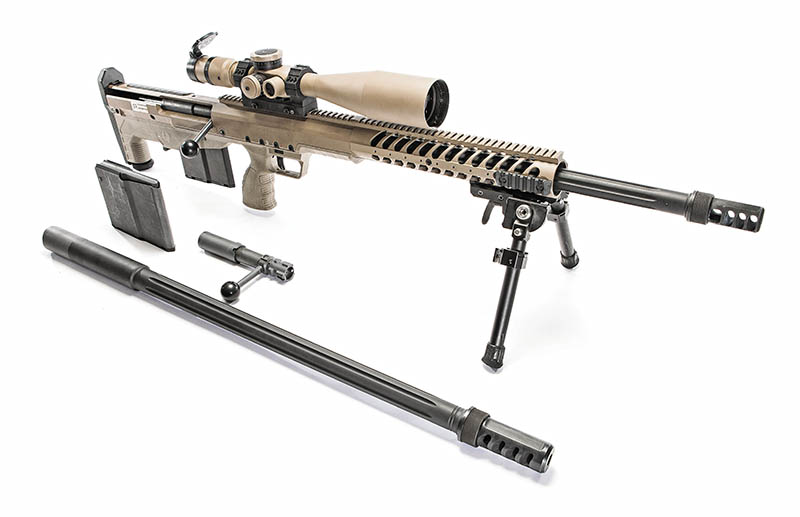
Setting Off, Doing No Good
Desert Tech’s website features a rifle builder. Configuring a gun exactly like our test sample, including spare caliber conversion, scope base, torque wrench (for barrel changes), color preferences and bipod, the total came to $11,234 … sans scope. The glass on our gun was a US Optics ER-25, which will run you an additional $3,301. Also, for reference, the two boxes of .375 CheyTac are $99 each, plus $74.50 for each of the two boxes of .50 BMG match. That makes the total cost of this T&E just shy of $15,000 give or take the cost of food and gas. If you ask us, “Who the hell is buying these guns?” Our honest-to-God answer is, “We don’t know.”
Aside from organizational purchases (military and law enforcement customers), we’re not sure who has that kind of coin to drop on a rifle that will literally punch you in the face if you don’t shoot it the way it wants to be shot. But if you’re out there, reading this story, there’s an opportunity for you. But make sure you get proper eye relief. And bring Band-Aids. Just in case.
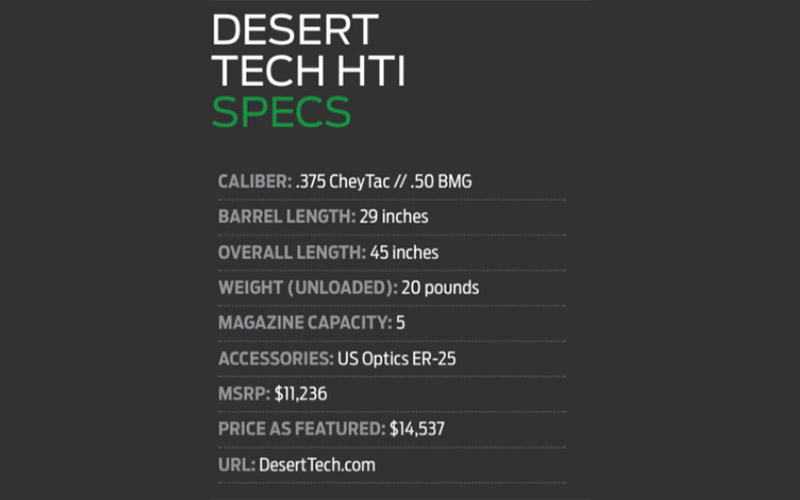
Editor's Note: This article originally appeared in RECOIL Issue 27.
More .50 BMG Stuff:
- The .50 BMG Ammo Buyer's Guide
- Ammo Brief: Going The Extra Mile With .50 BMG
- Handloading The .50 BMG
- The .50-Caliber Remington R2Mi
- Towsley On Target: .50 BMG Guns

Next Step: Get your FREE Printable Target Pack
Enhance your shooting precision with our 62 MOA Targets, perfect for rifles and handguns. Crafted in collaboration with Storm Tactical for accuracy and versatility.
Subscribe to the Gun Digest email newsletter and get your downloadable target pack sent straight to your inbox. Stay updated with the latest firearms info in the industry.

![Best Concealed Carry Guns In 2025 [Field Tested] Wilson Combat EDC X9S 1](https://gundigest.com/wp-content/uploads/Wilson-Combat-EDC-X9S-1-324x160.jpg)


![Best 9mm Carbine: Affordable PCCs [Tested] Ruger Carbine Shooting](https://gundigest.com/wp-content/uploads/Ruger-Carbine-Shooting-100x70.jpg)
![Best AR-15: Top Options Available Today [Field Tested] Harrington and Richardson PSA XM177E2 feature](https://gundigest.com/wp-content/uploads/Harrington-and-Richardson-PSA-XM177E2-feature-100x70.jpg)
